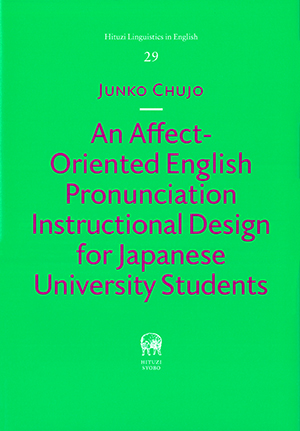2020年3月刊行
 |
Hituzi Linguistics in English No.29An Affect-Oriented English Pronunciation Instructional Design for Japanese University StudentsJunko Chujo(中條純子)著 菊判上製カバー装 198頁 定価11000円+税 ISBN 978-4-89476-922-9 |
【内容】
日本人大学生の英語音声の向上を目的としたインストラクショナルデザイン(教育設計)を提起し、実際の教材の開発過程を通して得た知見を授業改善に応用することで、口頭コミュニケーション能力の向上を目指す。特に学習者の情意領域(学習者の教育内容に対する態度、価値観の形成を行い、外国語学習を促進または妨げる要因を持つ領域)に注目し、英語音声面に対する心理的障壁を取り除くことを重視した教材の開発の戦略と方法を論じる。
【Contents】
Acknowledgements
CHAPTER 1 General Introduction
1.1 Introduction
1.2 Rationale for This Research
1.3 Aims of This Study
1.4 Structure of This Book
CHAPTER 2 Theoretical Background
2.1 Introduction
2.2 Pronunciation Teaching Approaches
2.2.1 Historical Overview
2.2.2 Issues in Pronunciation Instruction
2.3 English Pronunciation Teaching in Japan
2.3.1 Current Approach in Japanese English Education
2.3.2 Current State of English Pronunciation Teaching
2.3.3 Motivation and Traits of Japanese English Learners
2.4 The Concept of Instructional Design
2.5 Fundamental Concepts of this Pronunciation ID
2.5.1 The Three Learning Domains
2.5.1.1 The Cognitive Domain
2.5.1.2 The Psychomotor Domain
2.5.1.3 The Affective Domain
2.5.2 Phonetic Element Prioritization for Instruction
2.5.3 Pronunciation Goal Setting
2.5.4 Japanese University Pronunciation Textbooks
CHAPTER 3 Needs Analysis
3.1 Introduction
3.2 The Cognitive Domain
3.2.1 Methodology
3.2.2 Results
3.2.3 Conclusions and Pedagogical Implications
3.3 The Psychomotor Domain
3.3.1 Methodology
3.3.2 Results
3.3.3 Conclusions and Pedagogical Implications
3.4 The Affective Domain
3.4.1 Methodology 1
3.4.1.1 Results 1
3.4.1.2 Conclusions and Pedagogical Implications 1
3.4.2 Methodology 2
3.4.2.1 Results 2
3.4.2.2 Conclusions and Pedagogical Implications 2
3.5 Summary of Pedagogical Needs
CHAPTER 4 Design and Development
4.1 Introduction
4.2 Design
4.2.1 Pedagogical Goals
4.2.2 Design Principles
4.2.3 Instructional Strategies
4.3 Development
4.3.1 Developmental Phase 1
4.3.2 Developmental Phase 2
4.3.2.1 Unit Organization and Activities
4.3.2.1.1 Preparatory Unit
4.3.2.1.2 Tongue Twisters
4.3.2.1.3 Articulations
4.3.2.1.4 Marking
4.3.2.1.5 Rhythmic Reading
4.3.2.1.6 Words and Phrases
4.3.2.1.7 Minimal Pairs
4.3.2.1.8 Pictures with Phonetically Confusing Sentences
4.3.2.1.9 Word Definitions
4.3.2.1.10 Chants
4.3.2.1.11 Topic Dialogue (1)
4.3.2.1.12 Topic Dialogue (2)
4.3.2.1.13 Travel Tips
4.3.2.1.14 Recitation
4.3.2.1.15 Pop song
4.3.2.1.16 Authentic Information
4.3.2.1.17 Self-evaluation
4.3.2.2 Implementation and Formative Evaluation
4.3.2.2.1 Knowledge
4.3.2.2.2 Performance
4.3.3 Developmental Phase 3
4.3.3.1 Revised Instructional Principles
4.3.3.2 Revised Unit Organization
4.3.3.3 Revised Activity Descriptions
4.3.3.3.1 Self-checking
4.3.3.3.2 Review Exercises
4.3.3.3.3 Phonetic Analysis
4.3.3.3.4 Self- and Peer-monitoring
4.4 Research Questions
CHAPTER 5 Implementation and Evaluation
5.1 Introduction
5.2 Implementation
5.2.1 Participants
5.2.2 Procedures
5.3 Evaluation
5.3.1 Knowledge
5.3.2 Performance
5.3.3 Perception
5.3.4 Anxiety
5.3.5 Monitoring
5.4 Pedagogical Implications
5.4.1 Students’ Evaluation of the Instruction
5.4.2 Instructor’s Observations of the Acquisition Stage
CHAPTER 6 Conclusions
6.1 Introduction
6.2 Research Review
6.3 Limitations and Suggestions for Future Study
6.4 Concluding Remarks
References
Index
【著者紹介】
中條純子(ちゅうじょう じゅんこ)
東京電機大学講師。主な研究分野は、英語教育学、英語教材開発論。
主な著書にNow I Got It! A Fun Guide to English Pronunciation (三修社、2017)など。
ご注文は、最寄りの書店さんでお願いします。
お店に在庫が無くても、お取り寄せができます。
書店が最寄りにない場合は、オンライン書店でご注文ください。


お急ぎの場合は、小社あてにご注文いただくこともできます。
郵便番号、ご住所、お名前、お電話番号をメールか、FAXでお知らせください。
